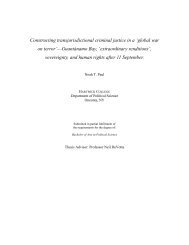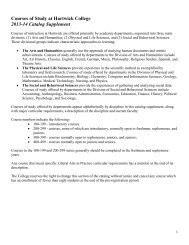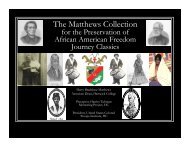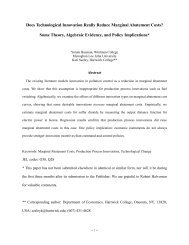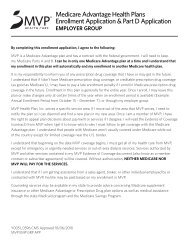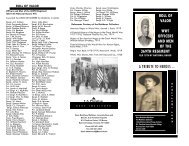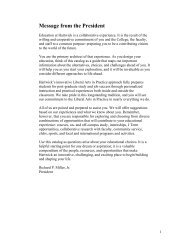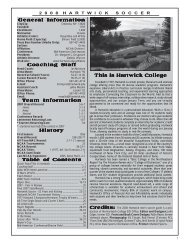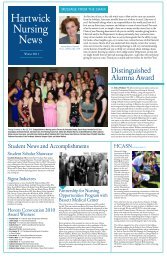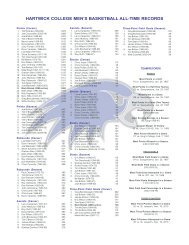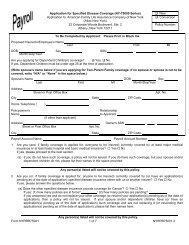Table of Contents - Hartwick College
Table of Contents - Hartwick College
Table of Contents - Hartwick College
You also want an ePaper? Increase the reach of your titles
YUMPU automatically turns print PDFs into web optimized ePapers that Google loves.
the South; the place <strong>of</strong> the Southern colonies in the Atlantic World; the<br />
place <strong>of</strong> the Southern states in the early republic and antebellum period;<br />
race, class, and gender in Southern life; the question <strong>of</strong> change and<br />
continuity in Southern history; and the New South.<br />
275 American Indian History to 1700 (3 credits) From the peopling<br />
<strong>of</strong> the New World some 20,000 plus years ago to 1700, the rise <strong>of</strong><br />
civilizations, the differentiation <strong>of</strong> cultures and the impact <strong>of</strong> European<br />
civilization on Indian America are mapped out and probed. The first third<br />
<strong>of</strong> the course will emphasize Indians’ world views and their relationships<br />
with each other and their varying environments. The course will examine<br />
the social, religious, technological, ecological and political changes that<br />
impacted Indian societies between 1492 and 1700. (NTW) or (SBA)<br />
276 American Indian History since 1700 (3 credits) The interaction<br />
between Native Americans and the U.S. from 1700 to the present. The<br />
topics covered include: wars and alliances, trade patterns, revitalization<br />
movements, federal-Indian relations, philanthropic and missionary<br />
activities, the reservation period, Red Power, etc. (NTW) or (SBA)<br />
283 Western Medicine since 1500 (3 credits) The history <strong>of</strong> Disease<br />
and its treatment in Europe and the United States since the reform <strong>of</strong> the<br />
study <strong>of</strong> anatomy by Andreas Versalius. While the overall theme will be<br />
the development <strong>of</strong> medicine as a science and a pr<strong>of</strong>ession, attention will<br />
also be given to traditional medicine, women as healers, epidemics and<br />
the 19 th century public health movement, and the vexed relationship<br />
between the State commercialism and the delivery <strong>of</strong> healthcare after<br />
1880. (WHS)<br />
305 The Renaissance (4 credits) This course will not be a chronological<br />
survey. The origins <strong>of</strong> the idea <strong>of</strong> the “Renaissance” and how this concept<br />
has framed Western perceptions <strong>of</strong> modernity will be considered. The<br />
functional practicality <strong>of</strong> applying this concept to Italian culture and<br />
society between 1350 and 1550 will be investigated. The course has two<br />
goals: to provide an understanding <strong>of</strong> the world <strong>of</strong> the Italian Renaissance<br />
and to critique the values we have associated with that world.<br />
Prerequisites: 209, 210 or instructor’s permission. (WHS)<br />
306 Reformation Europe 1450-1600 (4 credits) This course<br />
examines the dissolution <strong>of</strong> Medieval European culture as a system <strong>of</strong><br />
regulated religious beliefs and established political relations between the<br />
Roman church and secular powers. It also will consider the economic<br />
dislocation and social tensions that animated the Reformation passions,<br />
and examine the reintegration <strong>of</strong> these dynamic factors into new systems<br />
<strong>of</strong> belief and power during the age <strong>of</strong> confessional struggles. Prerequisites:<br />
Hist 209, 210 or instructor’s permission. (WHS)<br />
308 Enlightenment and Revolution (4 credits) This course examines<br />
the efforts <strong>of</strong> 18 th century intellectuals to rationalize the experiences <strong>of</strong> the<br />
17 th century crises. It analyzes the political and social culture <strong>of</strong> the Old<br />
Regime and the growing friction among the powerful nation-states in<br />
Europe and overseas. Finally it considers the social, economic and<br />
political pressures which culminated in the French and Industrial<br />
revolutions and traces the trajectories <strong>of</strong> those revolutions. Prerequisites:<br />
Hist 210, 212, or instructor’s permission. (WHS)<br />
324 Slavery in Latin America and the Caribbean (4 credits) This<br />
course examines how the institution <strong>of</strong> slavery was transplanted in Latin<br />
149



